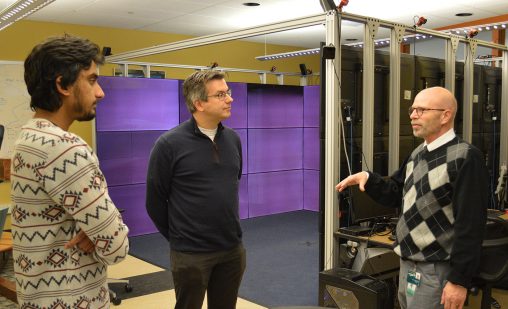
Paul Hershberger, right, professor in the Department of Family Medicine, discusses a virtual and augmented reality immersion program with Thomas Wischgoll, center, professor of computer science, and Suneesh Menon, a graduate computer science and engineering student.
A multidisciplinary team of Wright State University researchers has been awarded funding from the Ohio Department of Medicaid for $469,813 to advance health equity for the Medicaid population by increasing Medicaid provider cultural competency and awareness of implicit bias through training composed of virtual and augmented reality.
In addition to Wright State, Case Western Reserve University, Ohio University, The Ohio State University, the University of Cincinnati and the University of Toledo also received funding from the Ohio Department of Medicaid to develop virtual reality and simulated patient experiences.
The Wright State team is developing a virtual and augmented reality immersion program. The team includes faculty and staff from the Boonshoft School of Medicine, College of Engineering and Computer Science and the Center for Teaching and Learning. The team also includes seven graduate assistants from the Department of Computer Science and Engineering.
The co-principal investigators are Paul J. Hershberger, Ph.D., professor and director of the Division of Behavioral Health in the Department of Family Medicine at the Boonshoft School of Medicine, and Yong Pei, Ph.D., associate professor of computer science and engineering and director of the SMART Lab in the College of Engineering and Computer Science.
Hershberger said that this is an ideal way for health care providers to better understand the challenges Medicaid patients face.
“As the Medicaid population becomes more multicultural, it is vital for health care providers to become more culturally proficient,” he said. “By addressing implicit bias with health care providers, we can reduce health disparities and improve patient care and health outcomes.”
The virtual and augmented reality program will build upon the Life Course game, an interactive training tool for health professionals designed to help players better understand the social determinants of health, the economic and social conditions that affect an individual’s health. The Boonshoft School of Medicine uses the game to teach social determinants of health to medical students, residents and other health professions students.
Sabrina Neeley, Ph.D., associate professor and director of the Population Health Curriculum at the Boonshoft School of Medicine, explained that educating health care providers on the social determinants of health can make a significant difference in the health care outcomes of patients.“Education, income, family situation and employment play a role in the health outcomes of vulnerable populations,” she said. “By playing this Life Course game, health care providers will realize that those born with fewer resources face more challenges throughout life.”
Building on the digital version of the game, the team is developing an engaging exercise by adding virtual and augmented immersion at the point where the game participant visits a community health center. The link to the virtual and augmented reality will include four elements of the health center visit: preparation for and transportation to the appointment; check-in at the health center; interaction with the health care provider; and filling prescriptions.
The team will develop different versions of the game, based on the cases of a pregnant woman with a history of opioid use disorder and an immigrant with limited English proficiency. Social determinants of health, such as adverse childhood experiences in the case of the pregnant woman and a language barrier in the case of the immigrant, will be emphasized in the game.
Pei said that this is an opportunity to make advances in virtual and augmented reality for educational purposes. “The virtual and augmented reality immersion program will provide health care providers an immersive experience that will enable them to become more sensitive to the issues patients face,” he said.
Hershberger and Pei expect the design and development to be completed by the end of March. The program will be rolled out to Medicaid providers beginning in April.
“We hope to reach 200 Medicaid providers in the state of Ohio by June,” Hershberger said. “Our goal is for the Ohio Department of Medicaid to use our virtual and augmented reality immersion program well beyond the grant period that will conclude at the end of June.”
The Medicaid Equity Simulation Project is funded by the Ohio Department of Medicaid and administered by the Ohio Colleges of Medicine Government Resource Center. The views expressed in this news release do not represent the views of the state of Ohio or federal Medicaid programs.

 Wright State Police Department delivers major donation to Raider Food Pantry
Wright State Police Department delivers major donation to Raider Food Pantry  Wright State engineering and computer science students earn prestigious federal SMART Scholarships
Wright State engineering and computer science students earn prestigious federal SMART Scholarships  Wright State Police Chief Kurt Holden selected for prestigious FBI National Academy program
Wright State Police Chief Kurt Holden selected for prestigious FBI National Academy program  Wright State’s Raj Soin College of Business ranked among the best for entrepreneurs by Princeton Review
Wright State’s Raj Soin College of Business ranked among the best for entrepreneurs by Princeton Review  Wright State’s annual Raidersgiving draws hundreds
Wright State’s annual Raidersgiving draws hundreds 